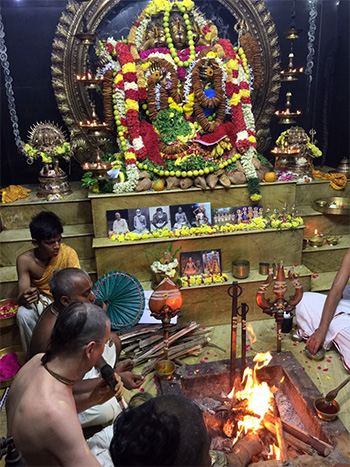Question: Could you please tell me where the caste system originated from, if the majority of hindus recognize it, and where the current caste system problems stem from.
Thank you for writing. You are correct that the present caste system is not something originating in the Hindu religion. According to the hindu scriptures caste was nothing but a term for one’s occupation. If one was a teacher he was called a brahmana; if one was a soldier; he was called a kshatriya; if one was a business man or a farmer he was called a vaishya; and if one was a laborer he was called a shudra. This had nothing to do with one’s birth, but with one’s qualities and actions. There are countless examples in the Hindu scriptures of people being born to parents of one caste, but becoming a different caste by training. In additon to this, caste was never used to discriminate against people. The different castes are described in the scriptures as the different limbs (arms, legs, stomach and head) of society. One does not discriminate against one’s own legs just because they perform a different function than one’s head. All of one’s bodily limbs are working for the common body, and as such all are respected
equally.
The Vedic society is divided into four divisions of occupation (varnas) and for orders of life (ashramas). This system is known as varnashrama. Since your questions are on the caste system, I will avoid speaking about the four orders of life, even though they intersect with the four divisions of occupation.
The four divisions of occupation (known today as caste) are actually based on one’s acquired nature. Originally this system was not based on birth. This is explained in the ancient scripture Bhagavad Gita as follows:
catur-varnyam maya srishtam
guna-karma-vibhagashah
tasya kartaram api mam
viddhy akartaram avyayam
“According to the three modes of material nature and the work associated with them, the four divisions of human society are created by Me. And although I am the creator of this system, you should know that I am yet the nondoer, being unchangeable.”
The four “castes” or varnas were determined according to one’s qualitities (guna) and one’s activities (karma) – and not by birth. This system of division of occupations exists naturally in every culture of the world. According to one’s qualities, one will perform activity (an occupation), and according to one’s occupation one is given a designation. In the English we use the names teachers, administrators, farmers and manual laborers. In sanskrit these are called brahmanas, kshatriyas, vaishyas and shudras. The words may be different, but these natural divisions exist in every society.
The four divisions of society work together as one body. The scriptures figuratively describe the body of society with the head being the brahmanas (the intellectual class), the arms being the kshatriyas (the adminstrative class), the stomach being the vaishyas (the agricultural class), and the legs being the shudras (the worker class).
The Vedic society was ran by a king (who belonged to the kshatriya class). This king was guided and advised by the brahmanas, and based on their proper guidance the king would administer the society. The vaishyas (business men) were mainly engaged in agriculture and cow protection. In the vedic culture the cow is considered as wealth, since the milk it produces sustains the entire society.
Each caste or varna has a particular definition based on qualities and activities. In the Bhagavad Gita the following definitions are given:
brahmana-kshatriya-visham
shudranam ca parantapa
karmani pravibhaktani
svabhava-prabhavair gunaih
“Brahmanas, kshatriyas, vaishyas and shudras are distinguished by the qualities born of their own natures in accordance with the material modes, O chastiser of the enemy.”
shamo damas tapah shaucam
kshantir arjavam eva cha
jnanam vijnanam astikyam
brahma-karma svabhava-jam
“Peacefulness, self-control, austerity, purity, tolerance, honesty, knowledge, wisdom and religiousness-these are the natural qualities by which the brahmanas work.”
shauryam tejo dhritir dakshyam
yuddhe chapy apalayanam
danam ishvara-bhavash cha
kshatram karma svabhava-jam
“Heroism, power, determination, resourcefulness, courage in battle, generosity and leadership are the natural qualities of work for the ksatriyas.”
krishi-go-rakshya-vanijyam
vaishya-karma svabhava-jam
paricharyatmakam karma
shudrasyapi svabhava-jam
“Farming, cow protection and business are the natural work for the vaisyas, and for the sudras there is labor and service to others.”
We find in the ancient scriptures of India there are many cases of someone belonging to one caste changing to another caste by developing the proper qualities. For example, the great king Kaushika became the most famous brahmana by the name Vishwamitra.
Today the natural divisions of society have degraded into a birth based caste system. This is not in accordance with the ancient scriptures. People without any good qualities are claiming to be brahmanas simply based on their birth. In the ancient text known as Bhagavata Purana it was predicted that in the future caste will be determined by birth, and the only qualification of the brahmana will be the string he wears around his shoulder – vipratve sutram eva hi.
In India the brahmanas wear a thread which is part of their ceremonial dress. Today external symbols such as the thread are the only qualification which establishes one as a brahmana. The inner qualifications of peacefulness, self-control, austerity, purity, tolerance, honesty, knowledge, wisdom and religiousity are ignored.
In summary, the present caste system has been manufactured by men for the purpose of exploiting society. The original divisions of society are natural and spontaneous. They exist in every society under different names and designations.
Receive our daily email newsletter on Hinduism, Yoga, Meditation, Ayurveda and Natural Healing.






